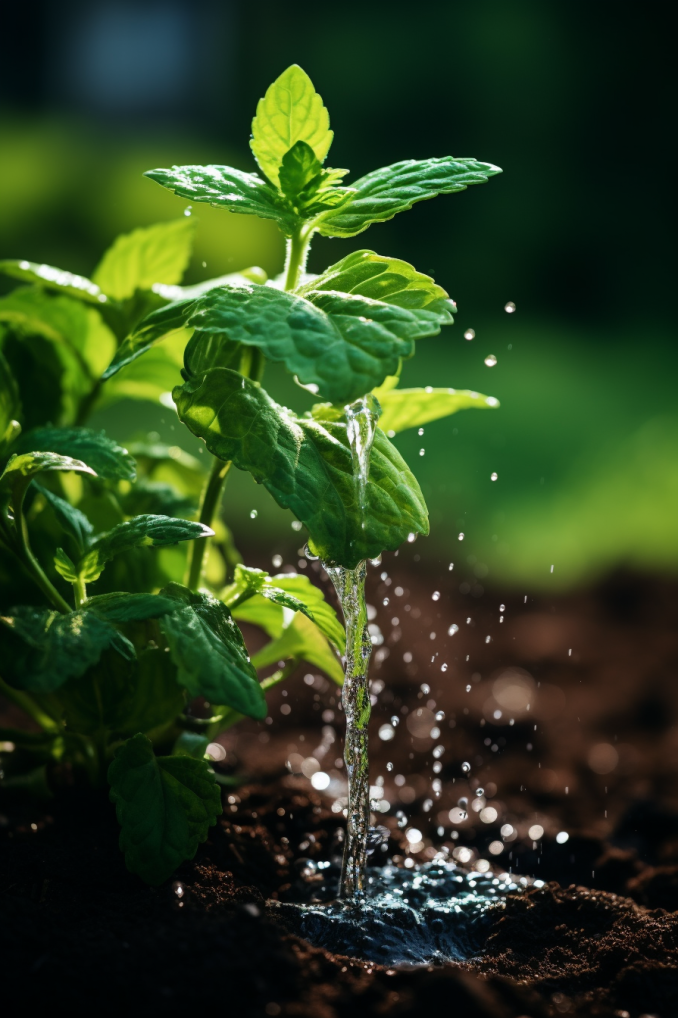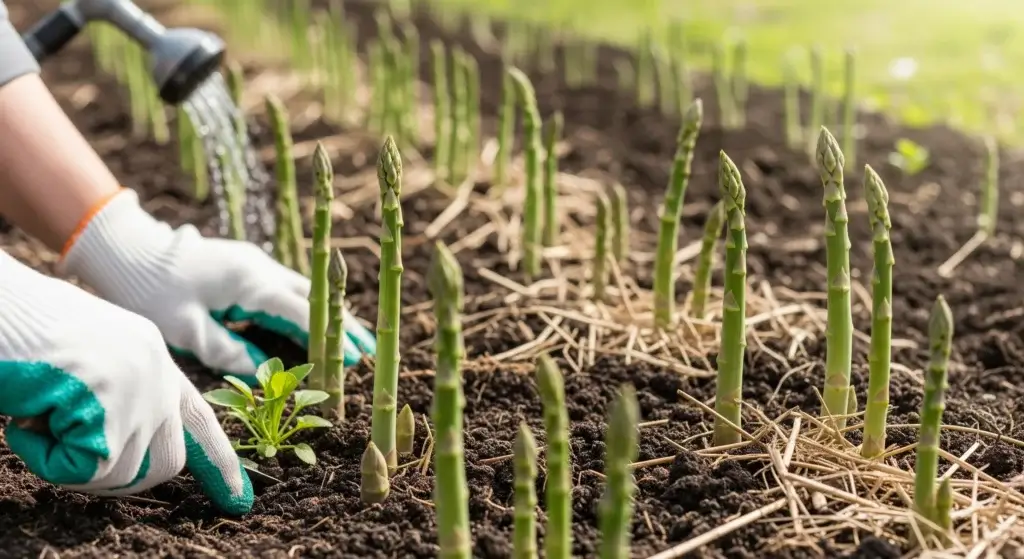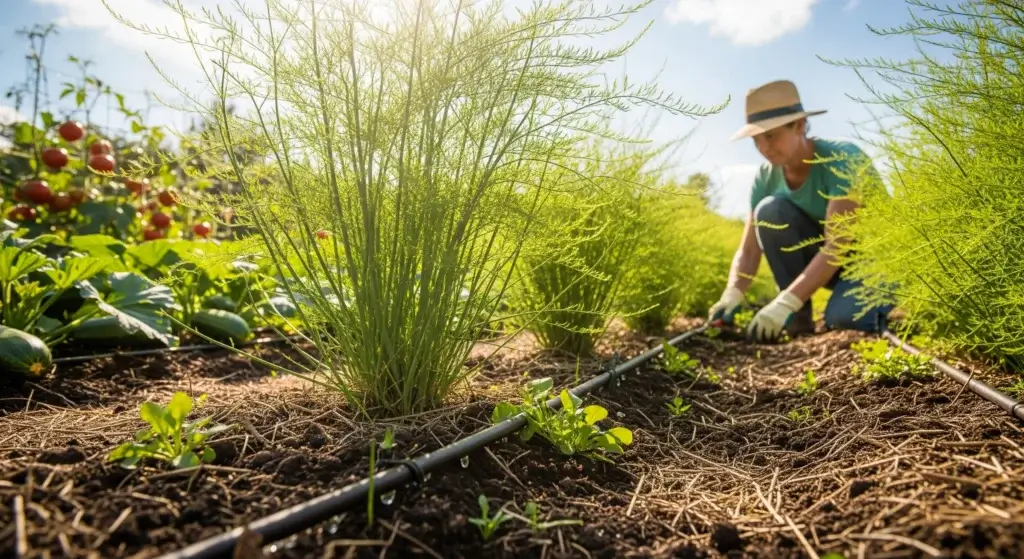
Mint with its refreshing aroma and versatility, is a delightful addition to any garden.
Besides its culinary uses, cultivating mint brings a myriad of benefits, making it a favorite among gardeners.
However, one crucial aspect that ensures a flourishing mint garden is proper watering techniques.
In this guide, we’ll explore the essentials of watering mint plants and unraveling the key practices that guarantee a vibrant and healthy mint garden.
Characteristics of Mint Plants
Mint plants, part of the Mentha genus, are renowned for their refreshing fragrance and culinary uses. Here are some key characteristics:
- Related post: The Ultimate Aloe Plant Watering Care Guide
- Related post: Unveiling the Secret of Corn Plant Watering
Rapid growth
Mint plants are known for their vigorous and speedy growth.
Their ability to spread quickly is attributed to their underground rhizomes, which can rapidly produce new shoots and extend the plant’s reach.
Hardy nature
These plants are generally robust and resilient, thriving in various conditions.
They can adapt to different soil types and climates, making them relatively easy to grow for beginners and seasoned gardeners alike.
Affinity for moist soil
Mint plants love living in consistently moist soil. Keeping them well-hydrated is key to their lush, healthy growth.
Yet, too much water can harm them, causing problems like root rot.
Growth characteristics
They tend to grow low to the ground, with square stems, and typically reach heights of about 12-36 inches (30-91 cm) tall.
Growing conditions
Mints thrive in moist, well-drained soil and prefer partial shade to full sun. They can tolerate various soil types but prefer slightly acidic to neutral pH.
Propagation
Mint plants can be propagated easily from cuttings or by dividing their root system.
However, they tend to spread rapidly, so planting them in containers, pots or designated areas can help control their growth.
Pest resistance
Mint plants generally stand up well against various pests and diseases due to their hardy nature. Nonetheless, they can still fall prey to certain insects such as aphids or spider mites.

Watering’s Importance for Mint Plants
Now, onto the crucial aspect: watering. Proper watering techniques are the backbone of a thriving mint garden. It directly impacts the plant’s growth, health, and flavor.
Strengthening root structure
Mint plants possess shallow roots, demanding regular and precise watering.
Too much water can cause root rot, while insufficient water can lead to wilting and affect flavor.
Moisture balance
Mint, the versatile and refreshing herb, thrives on consistent moisture.
Its shallow root system can’t handle long periods of dryness or waterlogging.
So, watering plays a crucial role in maintaining a healthy and flavorful mint plant.
Fuel growth
Water is essential for photosynthesis, the process by which mint plants convert sunlight into energy for growth.
Without adequate water, mint plants become stunted and weak.
Maintain perky leaves
Mint’s signature vibrant green leaves need consistent moisture to stay plump and juicy.
Boost essential oils
The aromatic compounds that give mint its refreshing scent and taste are concentrated in its leaves and stems. Proper watering helps mint plants produce these oils.

Ideal Watering Practices for Mint Plants
Watering frequency
Growing season
Water your mint plants deeply about 2-3 times per week during these seasons (spring and summer). Let the soil dry slightly between waterings.
This routine ensures the roots receive ample hydration without oversaturating the soil.
Cooler months
As temperatures cool down, adjust your watering schedule.
Reduce frequency to about once a week or even less, depending on the weather and how quickly the soil dries out.
Mint plants need less water in cooler months (fall and winter) to prevent waterlogging and maintain healthy growth.
Watering depth
Ensure a deep, thorough soak when watering your mint plants. This allows the water to penetrate deep into the soil, reaching the roots below the surface.
On the contrary, shallow watering—where only the top layer of soil gets damp—can pose problems.
It promotes shallow root development, making the plant more vulnerable to dehydration, particularly during dry spells or hot weather.
To avoid this, prioritize thorough watering that penetrates deeper into the soil, nurturing a stronger and healthier root system for your mint plants.
Watering method
When watering your mint plants, aim to water at the base of the plant rather than overhead.
This method helps prevent fungal diseases that can occur when leaves stay damp, attracting harmful pathogens.
For potted mint plants, water thoroughly until you see water coming out of the drainage holes.
This ensures the entire root ball gets properly saturated with water, promoting healthy growth and ensuring the roots have ample hydration.
This method helps maintain the plant’s well-being, particularly by avoiding potential fungal issues and ensuring optimal hydration for potted mint plants.
Watering timing
Opt for morning watering sessions for your mint plants when the weather is cooler.
This timing, typically early in the day, helps the water seep into the soil effectively before the day’s heat kicks in.
By doing so, you ensure the roots receive adequate hydration.
Avoid watering in the evening.
Damp leaves during the night can create a conducive environment for fungal diseases to thrive.
Keeping the foliage dry overnight reduces the risk of potential fungal issues, contributing to the overall health of your mint plants.
Soil considerations
Mint plants thrive in soil that strikes a balance: it should drain well yet retain enough moisture without getting overly soggy.
If your soil tends to be dense or clay-like, enhancing it with compost or organic matter can work wonders.
This addition helps improve drainage, ensuring the roots aren’t sitting in water.
For potted mint, using a saucer beneath the pot helps catch excess water.
However, remember to empty the saucer regularly to prevent the roots from getting waterlogged.
This simple step protects against root rot and keeps your potted mint plants healthy.
Signs of overwatering
- Wilting: Ironically, overwatered mint plants may show signs of wilting. This occurs because waterlogged roots struggle to absorb oxygen, impacting the plant’s ability to take up water and causing wilting.
- Yellowing leaves (root rot): Leaves turning yellow, especially starting from the bottom of the plant, can indicate overwatering. This is often due to root damage caused by excess moisture.
- Mold or mildew: Excessive moisture can create a favorable environment for mold or mildew growth, particularly on the soil surface or on the leaves.
- Stunted growth: Too much water can hinder nutrient uptake, leading to stunted growth despite seemingly favorable conditions.
Signs of underwatering
- Wilting: Similar to overwatering, underwatered mint plants will wilt. This occurs as a result of insufficient water reaching the leaves due to dry soil.
- Crispy or curling leaves: Leaves may become crispy or curl at the edges when the plant lacks water. This is a defense mechanism to conserve moisture.
- Drooping leaves: The leaves may start to droop or appear limp, signaling the need for water.
- Slow growth: Underwatered mint plants might exhibit slower growth or reduced vigor as they struggle to cope with limited water availability.
Woody stems
Woody stems in mint plants occur as they age, getting tougher naturally.
Stress factors like dry conditions or crowding can also lead to this.
Trimming older stems helps new growth. Different mint types may show varied woody growth.

Tips for Successful Mint Plant Watering
- Mulching Benefits: Mulching around mint plants acts like a protective shield, keeping moisture locked in the soil. This not only reduces water evaporation but also helps regulate soil temperature.
- Morning Watering: Watering in the morning has its perks. It allows the leaves to dry out during the day, minimizing the chances of fungal diseases. Moist foliage at night can create a breeding ground for fungi, so watering earlier helps keep the leaves dry and healthy.
- Water Temperature Matters: Using room temperature water is essential. Extreme temperature changes can shock the delicate roots of mint plants, affecting their health and growth.
- Water-Soluble Fertilizer: Use water-soluble fertilizer to easily nourish mint plants with vital nutrients like nitrogen, phosphorus, and potassium for healthy growth.
- Regular Harvesting: Frequent harvesting encourages new growth in mint plants, ensuring a bushier, healthier plant and a continuous supply of fresh mint for your needs.
Conclusion
To wrap up, getting the hang of watering mint plants is crucial for a thriving mint garden.
When you grasp what the plant requires and use the right watering methods, you’re on track to nurture a lively, tasty, and healthy mint garden.
- Related post: Different Types of Drip Irrigation Emitters
- Related post: How to Lower pH in Soil for a Thriving Garden
FAQs
Aim for consistent moisture, watering when the top inch of soil feels slightly dry.
Yes, but allow it to come to room temperature before watering.
Trimming away wilted or excess growth can help maintain the plant’s health during watering routines.



